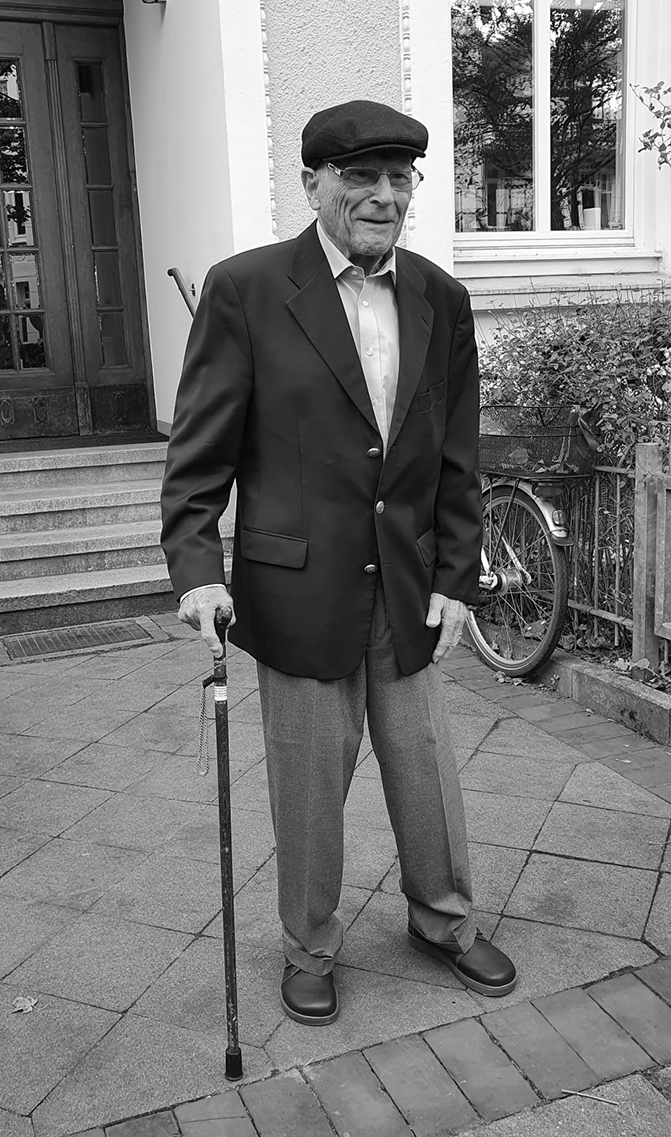Search for Names, Places and Biographies
Already layed Stumbling Stones
Suche
Kurt Henry Teitelbaum * 1923
Haynstraße 9 (Hamburg-Nord, Eppendorf)
HIER WOHNTE
KURT HENRY
TEITELBAUM
JG. 1923
FLUCHT 1939
KINDERTRANSPORT
SCHOTTLAND
further stumbling stones in Haynstraße 9:
Käthe Goldschmidt, Elisa Groth
Kurt Teil, formerly Teitelbaum, born on 31 Aug. 1923, fled to Britain and USA, survived
Haynstrasse 9 (Hamburg-North, Eppendorf)
Kurt Teil, formerly Teitelbaum, born on 31 Aug. 1923, and his sister Lotte, born on 31 Mar. 1922, lived with their parents Hermann Teitelbaum, born on 13 Aug. 1890, and Ilse Teitelbaum, born on 24 Mar. 1893, in Hamburg-Eppendorf. The father worked in a senior position at the Warburg Bank. The family lived in upscale circumstances in a spacious apartment. They belonged to the Hamburg Jewish Community but did not maintain a religious lifestyle.
In 1933, the family moved to Abendrothsweg 17, also in the Eppendorf quarter.
Son Kurt, enrolled in a public school, had to transfer to the Talmud Tora Realschule [a practice-oriented secondary school up to grade 10] in 1936, presumably because of the law against overcrowding in schools and universities dated 25 Apr. 1933, which stated that the proportion of "non-Aryans” in individual schools could not exceed 1.5%. For Kurt, the new school, which meant liberation from anti-Semitic classmates and teachers for other Jewish boys, did not necessarily bring about an improvement. Kurt later said, "Suddenly I, actually an atheist, was being taught by Orthodox teachers. I made a fuss because I was interested in facts and not in beliefs.”
In 1938, he witnessed teachers arrested during the November Pogrom return from concentration camp detention sick and scarred. He remained at school until his parents were able to get a place for him and his sister on a "children transport” (Kindertransport) to Britain in 1939.
According to an ordinance the Teitelbaums in Hamburg, like other Jews, had to surrender all objects made of gold, platinum or silver, as well as gemstones and pearls, to the "purchasing points” within two weeks by the end of Feb. 1939. As a bank official, Hermann Teitelbaum was also under general suspicion of foreign currency offenses: The customs investigation department opened proceedings against him on suspicion of foreign currency smuggling, which, however, remained without result. He was able to flee to Britain in 1939.
The person remaining back in Hamburg was the mother, who had received a visa to the USA according to an entry in the Jewish Community’s Jewish religious tax (Kultussteuer) card file in 1940; according to her son’s recollection, in Dec. 1941. The father also followed to the USA with the children, thus reuniting the family.
The Teitelbaums settled in Pittsburgh, where they changed their last name, doing so also for fear of American Nazis. The son recalls that at first the children supported the family because the parents spoke poor English. He himself earned money by shining shoes and washing cars. In the evenings, he attended high school. As a young adult, he became a naturalized citizen and enlisted in the U.S. Air Force in 1942. In Jan. 1945, he flew missions in air raids on German cities. He was in Berlin when Germany surrendered.
Kurt Teil’s family was saved, but two of his aunts were murdered in the Holocaust, as were many of his parents’ friends and acquaintances.
In Nov. 1945, he began working as a civilian investigator at the American "War Crimes Branch” headquarters in Wiesbaden with the goal of tracking down Gestapo or SS men who had murdered U.S. aviators in captivity. He successfully hunted war criminals in Germany for two years.
Today, Kurt Teil resides in Germany again. In 2019, he visited in Hamburg the apartment on Haynstrasse where he had spent part of his childhood. In 2020, he had a Stolperstein placed there for himself.
Translator: Erwin Fink
Kindly supported by the Hermann Reemtsma Stiftung, Hamburg.
Stand: August 2021
© Beate Meyer
Quellen: Diese Kurzbiographie wurde auf der Grundlage zweier Artikel verfasst: Katja Iken, "Ich tanzte auf Hitlers Asche", in: Spiegel v. 29.7.2019, https://www.spiegel.de/geschichte/ich-tanzte-auf-hitlers-asche-a-496d1397-0002-0001-0000-000165026479 (kostenpflichtig) (Zugriff 6.4.2020); Matthias Iken, Der lebende Stolperstein, in: Hamburger Abendblatt https://www.abendblatt.de/hamburg/article230930122/Kurt-Teil-Der-lebende-Hamburger-Stolperstein.html (Kostenpflichtig) (Zugriff 8.4.2020); zudem StaHH 552-1. 992 b, Kultussteuerkartei; Bundesarchiv Liste der jüdischen Einwohner des Deutschen Reichs 1933-1945; Bundesarchiv, R 1509, Ergänzungskarten zur Volkszählung v. 17.5.1939; Hamburger Adress- und Telefonbücher 1923-1939.


